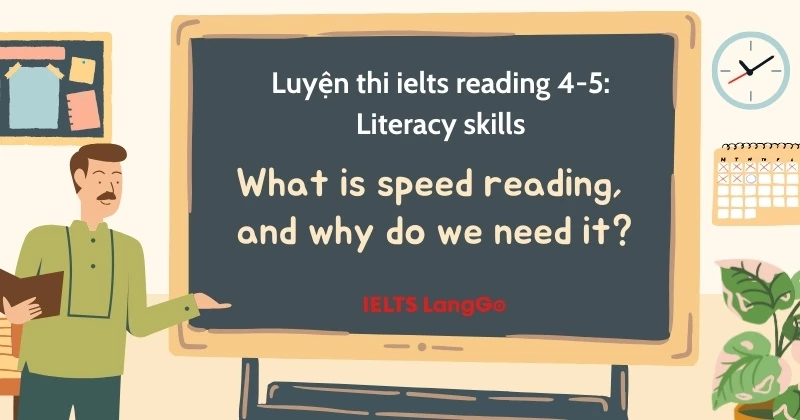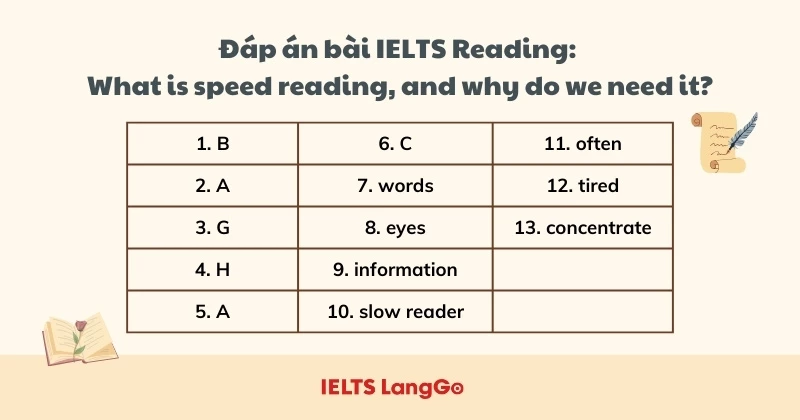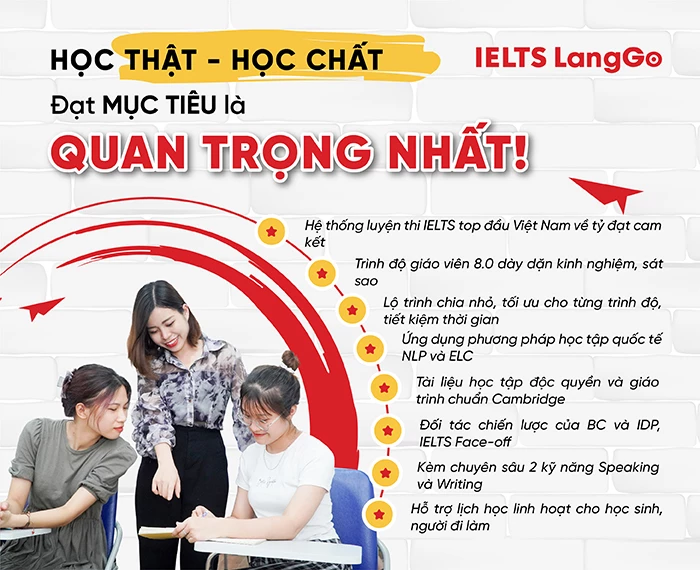



Duy trì được việc luyện tập bài thi IELTS reading trong vòng 1 tháng sẽ giúp cho bạn cải thiện được kỹ năng làm bài và rút ra được mẹo làm bài hiệu quả đó. Hôm nay chúng ta sẽ cùng luyện tập về dạng câu hỏi Literacy skills trong IELTS Reading với bài đọc "What is speed reading, and why do we need it?" nhé!
Trước tiên, IELTS LangGo sẽ cùng bạn nhắc lại một số lưu ý quan trọng khi làm 2 dạng bài Matching Information và Table Completion nhé!
Sau khi đã hiểu cách làm 2 dạng bài, các bạn hãy vận dụng ngay vào làm bài đọc dưới đây nhé!
| What is speed reading, and why do we need it? A Speed reading is not just about reading fast. It is also about how much information you can remember when you have finished reading. The World Championship Speed-Reading Competition says that its top competitors average between 1,000 and 2,000 words a minute. But they must remember at least 50 percent of this in order to qualify for the competition. B Nowadays, speed reading has become an essential skill in any environment where people have to master a large volume of information. Professional workers need reading skills to help them get through many documents every day, while students under pressure to deal with assignments may feel they have to read more and read faster all the time. C Although there are various methods to increase reading speed, the trick is deciding what information you want first. For example, if you only want a rough outline of an issue, then you can skim the material quickly and extract the key facts. However, if you need to understand every detail in a document, then you must read it slowly enough to understand this. D Even when you know how to ignore irrelevant detail, there are other improvements you can make to your reading style which will increase your speed. For example, most people can read much faster if they read silently. Reading each word aloud takes time for the information to make a complete circuit in your brain before being pronounced. Some researchers believe that as long as the first and last letters are in place, the brain can still understand the arrangement of the other letters in the word because it logically puts each piece into place. E Chunking is another important method. Most people learn to read either letter by letter or word by word. As you improve, this changes. You will probably find that you are fixing your eyes on a block of words, then moving your eyes to the next block of words, and so on. You are reading blocks of words at a time, not individual words one by one. You may also notice that you do not always go from one block to the next: sometimes you may move back to a previous block if you are unsure about something. F A skilled reader will read a lot of words in each block. He or she will only look at each block for an instant and will then move on. Only rarely will the reader’s eyes skip back to a previous block of words. This reduces the amount of work that the reader’s eyes have to do. It also increases the volume of information that can be taken in over a given period of time. G On the other hand, a slow reader will spend a lot of time reading small blocks of words. He or she will skip back often, losing the flow and structure of the text, and muddling their overall understanding of the subject. This irregular eye movement quickly makes the reader tired. Poor readers tend to dislike reading because they feel it is difficult to concentrate and comprehend written information. H The best tip anyone can have to improve their reading speed is to practise. In order to do this effectively, a person must be engaged in the material and want to know more. If you find yourself constantly having to re-read the same paragraph, you may want to switch to reading material that grabs your attention. If you enjoy what you are reading, you will make quicker progress. |
Questions 1-6
The reading passage has seven paragraphs, A-H.
Which paragraph contains the following information?
Write the correct letter, A-H.
NB You may use any letter more than once.
1. ……………… the types of people who need to read more quickly
2. ……………… the fastest reading speeds
3. ……………… how a reader can become confused
4. ……………… why reading material should be interesting
5. ……………… a definition of speed reading
6. ……………… what you should consider before you start reading
Questions 7-13
Complete the table below.
Choose NO MORE THAN TWO WORDS from the passage for each answer.
Chunking
| Type of reader | Reading method | Effect of method on reader |
| skilled reader | • many 7. ……………… in a block • reader hardly ever goes back | • reader’s 8. ……………… do less work • more 9 is processed |
| 10. ……………… | • small blocks • reader 11. ……………… goes back | • reader easily gets 12. ……………… • finds it hard to 13. ……………… on passage |
ĐÁP ÁN CHI TIẾT

1. B
Dẫn chứng: Professional workers need reading skills to help them get through many documents every day, while students under pressure to deal with assignments may feel they have to read more and read faster all the time. (Dịch: Những người làm việc chuyên nghiệp cần kỹ năng đọc để giúp họ xử lý nhiều tài liệu mỗi ngày, trong khi sinh viên chịu áp lực làm bài tập có thể cảm thấy họ phải đọc nhiều hơn và đọc nhanh hơn mọi lúc.)
Giải thích: Đoạn B đề cập rõ ràng đến hai nhóm người cần đọc nhanh: Professional workers (người làm việc chuyên nghiệp) và Students (sinh viên). Đây chính xác là thông tin về "types of people" (các kiểu người) được yêu cầu trong câu hỏi.
2. A
Dẫn chứng: The World Championship Speed-Reading Competition says that its top competitors average between 1,000 and 2,000 words a minute. (Dịch: Cuộc thi Vô địch Đọc nhanh Thế giới cho biết các thí sinh hàng đầu của họ đọc trung bình từ 1.000 đến 2.000 từ mỗi phút.)
Giải thích: Đoạn A cung cấp số liệu cụ thể về tốc độ đọc nhanh nhất thông qua: Đề cập đến cuộc thi cấp cao nhất - World Championship; Cung cấp con số cụ thể: 1.000-2.000 từ/phút cho các thí sinh hàng đầu (top competitors). Đây là thông tin duy nhất trong bài về tốc độ đọc cao nhất được đo lường.
3. G
Dẫn chứng từ đoạn G: A slow reader will skip back often, losing the flow and structure of the text, and muddling their overall understanding of the subject. (Người đọc chậm sẽ thường xuyên quay lại, mất đi sự trôi chảy và cấu trúc của văn bản, và làm rối loạn sự hiểu biết tổng thể về chủ đề)
Giải thích: Đoạn văn mô tả người đọc bị bối rối khi họ "skip back often" (thường xuyên quay lại), dẫn đến "losing the flow" (mất đi sự trôi chảy) và "muddling their overall understanding" (rối loạn sự hiểu biết tổng thể).
4. H
Dẫn chứng từ đoạn H: If you enjoy what you are reading, you will make quicker progress. (Nếu bạn thích thú với những gì bạn đang đọc, bạn sẽ tiến bộ nhanh hơn)
Giải thích: Đoạn văn chỉ ra mối liên hệ trực tiếp: khi bạn "enjoy" (thích thú) với tài liệu đọc, bạn sẽ "make quicker progress" (tiến bộ nhanh hơn), đây chính là lý do tại sao tài liệu đọc cần phải thú vị.
5. A
Dẫn chứng từ đoạn A: Speed reading is not just about reading fast. It is also about how much information you can remember when you have finished reading. (Đọc nhanh không chỉ là về việc đọc nhanh. Nó còn là về lượng thông tin bạn có thể nhớ được sau khi đọc xong)
Giải thích: Định nghĩa đọc nhanh được nêu rõ qua hai yếu tố: không chỉ "reading fast" (đọc nhanh) mà còn liên quan đến "how much information you can remember" (lượng thông tin có thể nhớ được), tạo nên một định nghĩa đầy đủ về speed reading.
6. C
Dẫn chứng từ đoạn C: Although there are various methods to increase reading speed, the trick is deciding what information you want first. (Mặc dù có nhiều phương pháp để tăng tốc độ đọc, bí quyết là quyết định trước những thông tin bạn muốn)
Giải thích: Đoạn văn nhấn mạnh yếu tố cần cân nhắc đầu tiên là "deciding what information you want" (quyết định thông tin bạn muốn). Đây là "the trick" (bí quyết) cần xem xét trước khi bắt đầu đọc, giúp người đọc chọn phương pháp đọc phù hợp.
7. words
Dẫn chứng từ đoạn F: A skilled reader will read a lot of words in each block. (Một người đọc giỏi sẽ đọc nhiều từ trong mỗi khối)
Giải thích: Đoạn văn mô tả đặc điểm của "skilled reader" (người đọc giỏi) là đọc "a lot of words" (nhiều từ) trong mỗi khối. Từ "words" phù hợp với khoảng trống vì nó chỉ rõ đơn vị được đọc trong mỗi block.
8. eyes
Dẫn chứng từ đoạn F: This reduces the amount of work that the reader's eyes have to do. (Điều này giảm lượng công việc mà mắt người đọc phải làm)
Giải thích: Khi đọc theo khối, "reader's eyes" (mắt của người đọc) sẽ làm việc ít hơn. Từ "eyes" là đáp án chính xác vì nó là bộ phận cơ thể được đề cập trực tiếp trong việc thực hiện công việc đọc.
9. information
Dẫn chứng từ đoạn F: It also increases the volume of information that can be taken in over a given period of time. (Nó cũng tăng lượng thông tin có thể được tiếp nhận trong một khoảng thời gian nhất định)
Giải thích: Đoạn văn đề cập đến "volume of information" (lượng thông tin) được xử lý nhiều hơn. Từ "information" phù hợp vì nó chỉ ra chính xác những gì người đọc giỏi có thể xử lý được nhiều hơn trong một khoảng thời gian.
10. slow reader
Dẫn chứng từ đoạn G: On the other hand, a slow reader will spend a lot of time reading small blocks of words. (Mặt khác, một người đọc chậm sẽ dành nhiều thời gian đọc các khối từ nhỏ)
Giải thích: Đoạn văn sử dụng cụm từ "slow reader" để đối lập với "skilled reader". Đây chính là loại người đọc còn lại trong bảng so sánh về phương pháp chunking.
11. often
Dẫn chứng từ đoạn G: A slow reader will skip back often. (Một người đọc chậm sẽ thường xuyên quay lại)
Giải thích: Từ "often" (thường xuyên) mô tả tần suất người đọc chậm "skip back" (quay lại) khi đọc. Đây là một trong những đặc điểm khiến họ đọc không hiệu quả.
12. tired
Dẫn chứng từ đoạn G: This irregular eye movement quickly makes the reader tired. (Chuyển động mắt không đều này nhanh chóng khiến người đọc mệt mỏi)
Giải thích: Từ "tired" (mệt mỏi) là kết quả trực tiếp của việc di chuyển mắt không đều khi đọc. Bài đọc chỉ ra rằng người đọc chậm thường xuyên quay lại các đoạn trước, tạo ra chuyển động mắt không đều và dẫn đến tình trạng mệt mỏi này.
13. concentrate
Dẫn chứng từ đoạn G: Poor readers tend to dislike reading because they feel it is difficult to concentrate and comprehend written information. (Người đọc kém thường không thích đọc vì họ cảm thấy khó tập trung và hiểu thông tin viết)
Giải thích: Từ "concentrate" (tập trung) được sử dụng trong đoạn văn để mô tả khó khăn của người đọc kém. Họ gặp vấn đề trong việc "concentrate and comprehend" (tập trung và hiểu) nội dung khi đọc, là hệ quả của việc đọc không hiệu quả.
Như vậy, bài viết trên đã giup bạn luyện tập IELTS Reading chủ đề Literacy skills qua bài đọc What is speed reading, and why do we need it? kèm đáp án và giải thích chi tiết, đồng thời gợi ý cho bạn các cách làm bài IELTS Reading hiệu quả. Hãy luyện tập thường xuyên để đạt điểm cao trong bài thi IELTS bạn nhé!



ĐẶT LỊCH TƯ VẤN MIỄN PHÍ LỘ TRÌNH Săn ƯU ĐÃI lên tới 12.000.000đ